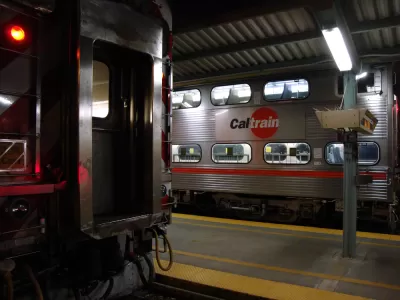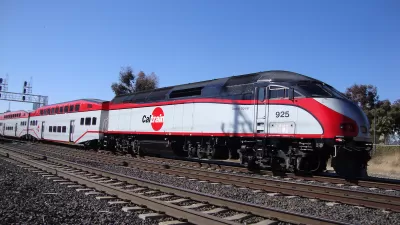Up against an unexpected federal requirement to produce substantially more funds for a crucial rail project, San Mateo County's transportation authority showed the importance of "self-help" counties that control local transportation sales tax funds.

"The San Mateo County Transportation Authority (SMCTA) essentially saved Caltrain’s electrification project last week by going above and beyond its partner agencies to meet timely federal requirements," reports Samantha Weigel for The Daily Journal. The 55-mile, San Francisco-to-San Jose commuter railroad is owned and administered by a joint powers board consisting of representatives from the three Peninsula counties of San Francisco, San Mateo, and Santa Clara.
The SMCTA agreed to allocate another $135 million toward the $2 billion project after federal transportation officials insisted those overseeing Caltrain’s modernization prove they could afford to finish even if construction costs increase.
A pause here is in order because this article is essentially about three seemingly unrelated issues:
- "Self-help" counties
- Consequences of an unsustainable state gas tax
- Caltrain electrification
San Mateo is a self-help county
Thanks to San Mateo County voters in 1988, San Mateo created a transportation authority to administer Measure A, a 20-year, half-cent transportation sales tax. Interestingly, the measure would not have passed today as it was approved by only 61.7 percent, well below the two-thirds, supermajority threshold required by the 1978 Proposition 13. A 1995 court case and Proposition 218 in 1996 would ensure that special tax measures pass with a super majority vote.
Measure A expired in 2008, but four years earlier, voters once again stepped up to support local transportation projects by renewing the tax for 25 years to 2033, this time by an incredible 75.3 percent, well above the 66.67 percent threshold.
Among the state's 58 counties, 20 are "self-help," i.e., they passed transportation sales taxes, according to the Self Help Counties Coalition (SHCC).
Readers may recall from the the evaluation of November's local ballot measures that Ventura and San Luis Obispo counties attempted to join that coalition by placing half-cent transportation sales tax measures on the ballot, but were unsuccessful.
Unsustainable state gas tax revenues
Last January, with the realization that the state Board of Equalization would be forced to adjust the state's gas tax, which was the highest in the nation in 2013, downwards for the third consecutive year, the California Transportation Commission resorted to a move of last resort by cutting "funding for road and transit projects by $754 million over the next five years," reported the Los Angeles Times. And the Federal Transit Administration (FTA) took notice.
"[On Jan. 3], the FTA announced locals couldn’t rely on a state funding source that’s been plagued by deficits due to a drastic drop in gas tax revenue, according to a SMCTA staff report," reports Wiegel, and asked that Caltrain come up with a $200 million contingency fund.
Self-help to the rescue
This is where self-help, or local transportation funding, became critical. SMCTA put up $135 million, and the Santa Clara Valley Transportation Authority, or VTA, followed [Jan. 5] with $65 million. Santa Clara County is also a self-help county. On Nov. 8, South Bay voters passed Measure B, an additional 30-year, half-cent sales tax by 71.74 percent earmarked for transportation projects.
[San Mateo County also renewed a 10-year, half-cent sales tax, Measure K, last November, but unlike Measure A, it is not earmarked for transportation projects as the tax revenue goes to the county general fund.]
Finally, what this article is really all about: funding the ongoing Caltrain electrification project
Caltrain combines electrification and the installation of the federally mandated Positive Train Control system into one project known as Caltrain modernization, totaling a hefty $2 billion.
As posted in July, Caltrain was waiting for two funding sources to come through:
- $713 million from the state, including $600 million from Proposition 1A, 2008 high-speed rail bonds.
- A $647 million federal grant should the FTA agree to a Federal full funding grant agreement.
The good news is that the California High-Speed Rail Authority did agree last month to the $600 million. Caltrain is still waiting to hear from FTA on the federal funds, but with the $200 million provided by SMCTA and VTA, chances of receiving it improved dramatically.
Last word goes to San Mateo County Supervisor Don Horsely, who also serves as vice chair of the Transportation Authority board, on why being a 'self-help' county is so beneficial.
“The bottom line is that the sales tax is a guarantee,” Horsley said. “I cannot emphasize how wise it was in the long run. … The only way we’re going to be able to address traffic issues is to have local funding to match state or federal funds.”
And transit issues as well.

Study: Maui’s Plan to Convert Vacation Rentals to Long-Term Housing Could Cause Nearly $1 Billion Economic Loss
The plan would reduce visitor accommodation by 25,% resulting in 1,900 jobs lost.

Alabama: Trump Terminates Settlements for Black Communities Harmed By Raw Sewage
Trump deemed the landmark civil rights agreement “illegal DEI and environmental justice policy.”

Why Should We Subsidize Public Transportation?
Many public transit agencies face financial stress due to rising costs, declining fare revenue, and declining subsidies. Transit advocates must provide a strong business case for increasing public transit funding.

Paris Bike Boom Leads to Steep Drop in Air Pollution
The French city’s air quality has improved dramatically in the past 20 years, coinciding with a growth in cycling.

Why Housing Costs More to Build in California Than in Texas
Hard costs like labor and materials combined with ‘soft’ costs such as permitting make building in the San Francisco Bay Area almost three times as costly as in Texas cities.

San Diego County Sees a Rise in Urban Coyotes
San Diego County experiences a rise in urban coyotes, as sightings become prevalent throughout its urban neighbourhoods and surrounding areas.
Urban Design for Planners 1: Software Tools
This six-course series explores essential urban design concepts using open source software and equips planners with the tools they need to participate fully in the urban design process.
Planning for Universal Design
Learn the tools for implementing Universal Design in planning regulations.
Smith Gee Studio
Alamo Area Metropolitan Planning Organization
City of Santa Clarita
Institute for Housing and Urban Development Studies (IHS)
City of Grandview
Harvard GSD Executive Education
Toledo-Lucas County Plan Commissions
Salt Lake City
NYU Wagner Graduate School of Public Service




























